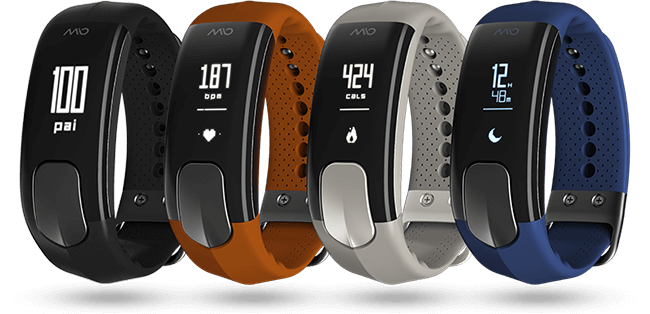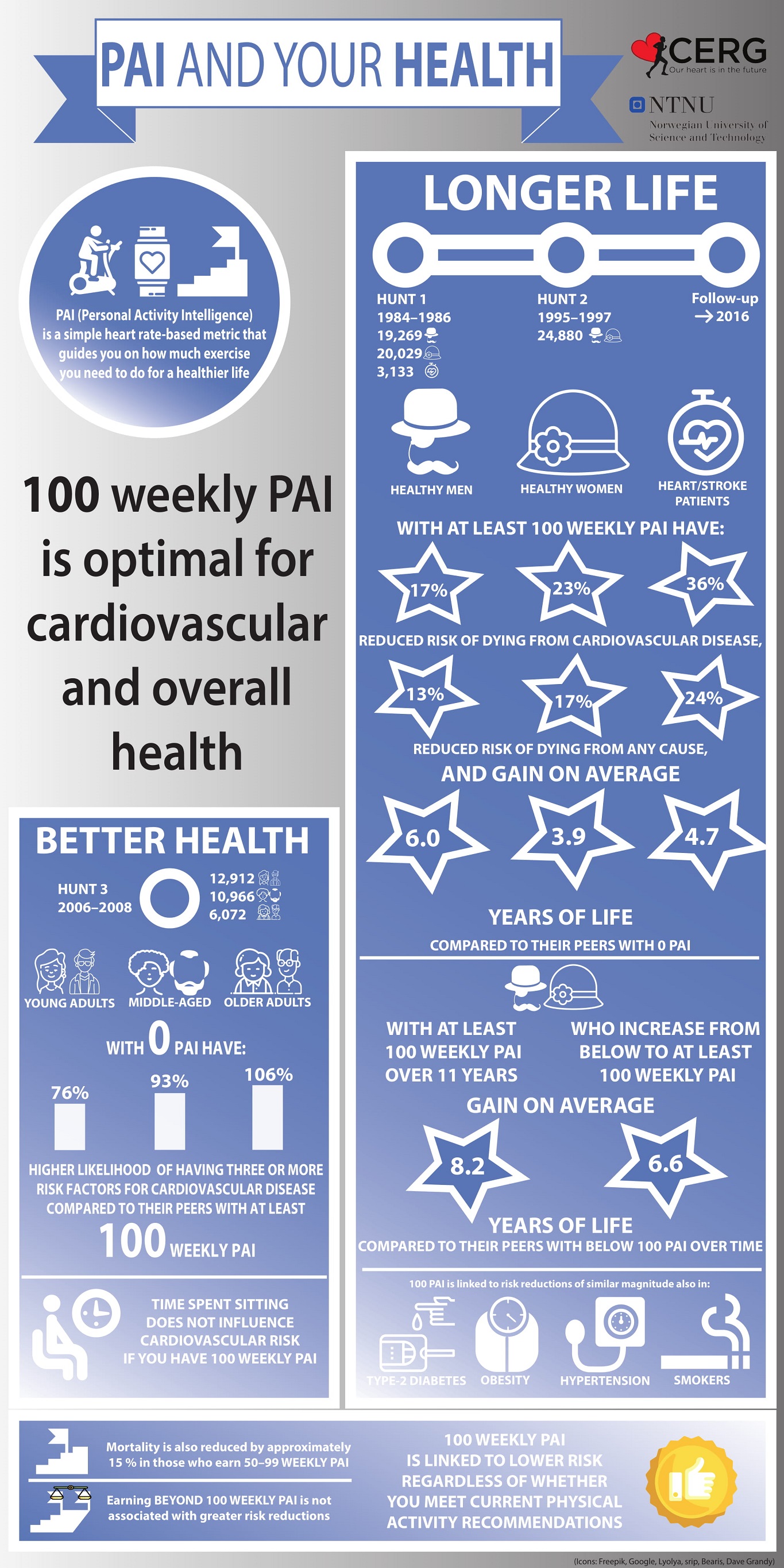Personal Activity Intelligence (PAI) - CERG


Activity Quotient (AQ) / Personal Activity Intelligence (PAI)
Exercise enough to get 100 AQ every week, and give yourself the best possible outlook for a long and healthy life.
What is PAI and how do you measure it?
PAI is short for Personal Activity Intelligence. You earn PAI points every time your heart rate increases: The higher heart rate, the faster you earn PAI. Our research shows that those who achieve 100 PAI or more every week over time live on average eight years longer than others.
PAI is based on the only thing that reflects the intensity of your activity: your heart rate. Everything you need to do in order to use PAI is to measure your heart rate continuously.
The best option to measure PAI is the Mia Health app, where available. This app, launched in 2023, is partly owned by the Norwegian University of Science and Technology, and can be used with most smart watches. Mia Health also allows people without heart rate monitors to measure PAI by manually logging their activity.
Please note: From September 2024, PAI in the Mia Health app is replaced by our new algorithm, AQ (Activity Quotient). In short, AQ is an even more accurate algorithm than PAI. We are now working to publish the first research articles on AQ, but the principles are the same as for PAI: 100 AQ and more is linked to optimal health, while there are also good health effects to be gained from lower AQ values.
As of January 2025, the Mia Health app is available in almost all of Europe, The United States and Canada, Australia and New Zealand, Taiwan and Brazil. Included in the Mia Health app is also a more advanced version of our Fitness Calculator, allowing you to track your health progress over time.

The PAI journey from Mio to Mia
Again, Mia Health provides the best user experience for the vast majority of those who want to track their PAI score. If the score in the app is 100 or higher, you're active enough. If not, you could reduce your health risk by becoming more physically active.
However, if your heart rate monitor is not supported by Mia Health today – or if Mia Health is not available in your country yet – you may consider trying one of the less convenient options for measuring PAI. Note that several of the watches and apps mentioned below have been phased out or are in the process of being phased out from the marked. Thus, we do not know how long it will be possible to measure PAI with these tools.
- The Mia Health app can be downloaded from Google Play (Android) and App Store (iPhone) in Norway, Denmark, Sweden, Australia and Ukraine. This app currently works with heart rate monitors from Fitbit, Apple Watch, Garmin, Polar, Suunto and Withings.
- Until October 2023, Norwegian and American users could also measure PAI with an app called Memento U. However, this app is no longer available.
- The leading Chinese smartwatch manufacturer Huami offers PAI on many of its watches, including the Amazfit and Zepp series. With watches from Huami, you get both PAI directly on your wrist and in the Zepp app.
- The heart rate monitor LYNK2 from AccurotFit measures PAI and is used together with the AccuroFit app.
- The Canadian company Mio was the first to make activity trackers with PAI integrated, way back in 2016. Mio no longer produces watches and no longer has an updated app. However, if you still have the Mio Slice or Mio Fuse, you can measure PAI by connecting these wristbands to the AccuroFit app.
- Before July 2022, you could measure PAI with the PAI Health app. Unfortunately, this app is no longer updated and has been removed from the app stores.
Why PAI and why 100?
More than five million deaths worldwide could have been prevented if people were more physically active. We believe that PAI could contribute to prevent cardiovascular disease and premature death by encouraging everyday people to be more active.
Our research shows that men and women in all age groups have far lower risk of early death and death from cardiovascular diseases if they exercise enough to obtain 100 weekly PAI. 100 PAI is optimal for smokers, obese persons, and individuals with hypertension or type 2 diabetes. Even those who achieve 50 PAI every week have considerable health benefits compared to those who are inactive.
We developed the PAI algorithm by using information from almost 5000 healthy Norwegians who had their maximum oxygen uptake tested during the HUNT3 Fitness Study. After that, we estimated PAI points for almost 40,000 healthy participants from the first HUNT study back in the 1980s. All of them had reported how much and how intense they exercised. Finally, we checked the health status of these 40,000 Norwegians almost 30 years later. The results showed that earning 100 PAI (or more) over a 7-day period is optimally assosiated with reduced risk of disease.
We have also validated PAI in populations from other countries. In a study of more than 56,000 US men and women followed for up to 30 years, 100 PAI was associated with 21% reduced risk of early death and 30% reduced risk of cardiovascular death, compared to being inactive.
And among 443,000 relatively healthy Chinese followed for up to nine years, the risk of dying from cardiovascular disease was 13–16% lower if 100 PAIs or more were achieved. The risk of dying from any cause was also reduced, and the health benefits of 100 PAI applied to men and women of all ages, smokers, people with high blood pressure, overweight and people with diabetes.
In the same population from China, we found a reduced risk of having a heart attack for those who exercised enough to achieve 100 PAI or more. This relationship was only statistically certain for people over 60 years of age, where 100 PAI was linked to a 16% reduced risk. The risk of dying from coronary heart disease, which includes myocardial infarction and angina pectoris, was reduced for anyone who achieved a PAI of 100 or more, regardless of age.
Improving PAI-score, lowering risk
Even if you exercise too little to achieve 100 PAI, it's not too late to start now. We looked at how increasing the PAI score over time was linked to mortality, and found that those who increased from less than 100 PAI a week in the first survey up to at least 100 PAI a week in the next survey eleven years later had lower risk of dying early than those who stayed below 100 PAI over time. The lowest risk was found in those who were physically active enough to reach 100 PAI or more at both the HUNT1 and HUNT2 surveys.
These results were also confirmed in a healthy American population. Women and men maintaining 100 PAI over time lived on average five years longer than those who remained inactive, and they had half the risk of dying from cardiovascular diseases. Furthermore, health benefits were also seen in those who increased from below to above 100 PAI between the two measurements.
PAI against dementia
People who maintain an activity level of 100 PAI over time have a significantly lower risk of developing dementia over the next 25 years, compared to those who are less physically active. Those who have previously been less physically active, but have increased the amount of exercise to at least 100 PAI - also have a reduced risk. The risk of dying from or with dementia is also reduced for those who exercise enough to achieve 100 PAI.
This study includes almost 30,000 women and men who were healthy when they participated in the Nord-Trøndelag Health Study in both the mid-1980s and 1990s. They were followed up until 2021. On average, participants who achieved at least 100 PAI lived almost three years longer without dementia than those who were less active.
Improved fitness and less weight gain with 100 PAI
Men and women with 100 weekly PAI or more also have significantly higher cardiorespiratory fitness than those with less than 100 weekly PAI. Obtaining 100–150 PAI over a 7-day period seems to secure having the average cardiorespiratory fitness expected for your age and sex.
High cardiorespiratory fitness is closely linked to good health and increased length of life. Importantly, the magnitude of the difference in cardiorespiratory fitness between those with higher and lower PAI scores than 100 is clinically relevant, and could possibly explain the link between maintaining at least 100 PAI and current and future health risk.
Moreover, healthy women and men who are physically active enough to achieve at least 100 PAIs every week for decades gain less weight than people who are inactive. HUNT participants who achieved at least 100 PAIs in the 1980s, 1990s and 2000s had healthier weight development than those who were inactive. The same applied to people who were inactive in the 1980s, but had increased their activity level to at least 100 PAIs in the last two health surveys.
Better than today's recommendations
PAI considers your age, your gender, your resting heart rate and your maximum heart rate. In other words, PAI is not based on the number of steps you walk or how many minutes of physical activity you perform each day. Those measurements do not consider the intensity of the activity. Therefore, we think that PAI is a more accurate and attractive activity standard to tell you if you actually exercise enough.
Today's recommendations state that adults should be physically active with moderate intensity for at least 150 minutes every week, or with high intensity for at least 75 minutes. Our research, however, clearly shows that even those who don't meet these activity standards have reduced risk of early death if they maintain 100 weekly PAI or more. Moreover, those who attend to the activity recommendations do not have reduced risk if they achieve less than 100 PAI every week.
100 PAI also for heart and stroke patients
Also people with cardiovascular disease should aim for 100 PAI to live longer. We estimated PAI in more than 3000 HUNT1 participants with previous myocardial infarction, angina or stroke, and followed them for up to 30 years. Those who achieved 100 PAI or more over a 7-day period had 36% lower risk of dying from cardiovascular causes compared to inactive patients. They also lived for an average of five years longer than those who earned less than 100 PAI. To achieve 100 PAI was a better predictor of future health benefits than achieving today's exercise recommendations.
In another study, we showed that persons who exercise enough to get 100 PAI over a 7-day period can sit a lot without having increased cardiovascular risk. The odds of having several cardiovascular risk factors was not increased compared to those who both had 100 PAI and low levels of sedentary behaviour.
PAI is well liked and efficatious in type 2 diabetes
A study from the USA indicates that using PAI is feasible, motivating and increases the level of physical activity in people who have an increased risk of cardiovascular disease. In the study, 25 patients were given a FitBit heart rate monitor and access to the PAI Health app, and they were encouraged to varied exercise that increased their heart rate and elevated the PAI score above 100 for the next 12 weeks.
22 of the patients completed the study. They maintained an average PAI score of 116 throughout the period, and reported both being more physically active and less sedentary than before joining the study. Over 80% were satisfied with PAI.
A goal of 100 weekly PAI helps persons with diabetes improve their exercise capacity and sleep, and to reduce their amount of body fat. Moreover, 80% of the patients were eager to continue using PAI after the research project.
Half of the 30 patients in the Australian pilot study were randomly selected to use a heart rate monitor and the PAI Health app to track their PAI score for 12 weeks. They also attended a total of four sessions to learn how to use the system and get examples on how to exercise. The PAI intervention also improved several aspects of health related quality of life, when compared to the group who received physical activity advice and sessions without any information about PAI.
PAI also motivates heart patients to become more physically active, according to a study from the same Australian research group. The 20 participants used PAI in cardiac rehabilitation after treatment for angina or heart attack, but only got to see their own PAI score in the last three weeks of the six-week rehabilitation program. During these three weeks, they were significantly more physically active than the first three weeks, and a higher proportion of patients managed to achieve at least 50 PAI each week. All participants recommended PAI, and a large majority wanted to continue measuring their PAI score after the study was over.
How to earn 100 PAI
It doesn't matter what type of activity you do to earn PAI – you could walk, run, cycle, row, swim or go skiing. All that matters is how high your heart rate is during the activity. Over a 7-day period, you need only two sessions totalling one hour of exercise to reach 100 PAI if the intensity is at least 80 % of your maximum heart rate. On the other hand, two and a half hours of moderate intensity activity will not give you more than approximately 45 PAI. You can achieve a maximum of 75 PAI points in one day.
The better your fitness is, the more physical activity is needed to achieve 100 PAI. In other words, PAI adjusts to your progress. If you are untrained and out of shape, you could earn your 100 PAI just by going for short walks regularly throughout the week, as that will raise your heart rate. If you are in shape and well trained, you will need to do more. Getting a PAI score of 100 is the goal for everyone, and no one has to be active every single day to get there.
It is easier to reach the first 50 PAI compared to the next 50. That is because the risk reduction for lifestyle diseases is greatest when progessing from total inactivity to some physically activity. This means that if you repeat a workout two days in a row, you will get less PAI on the second workout.

List of scientific publications on PAI
2024:
Nauman, J., Mirzaamin, T., Franklin, B. A., Nes, B. M., Lavie, C. J., Dunn, P., Arena, R., Weng, C. P., Tari, A. R. & Wisløff, U. (2024). Bolstering the Prognostic Utility of Coronary Risk Assessments with PAI: A Physical Activity Metric. Medicine and science in sports and exercise.
Gao, W., Sanna, M., Chen, Y. H., Tsai, M. K., & Wen, C. P. (2024). Occupational Sitting Time, Leisure Physical Activity, and All-Cause and Cardiovascular Disease Mortality. JAMA Network Open, 7(1), e2350680-e2350680.
2023:
Coombes, B. K., Bisset, L. M., Sierra-Silvestre, E., Ware, R. S., Coppieters, M. W., Coombes, J. S., & Burton, N. W. (2023). Personal Activity Intelligence eHealth intervention in people with diabetic peripheral neuropathy: A feasibility study. Australian journal of general practice, 52(11), 771-777.
Manskow, U. S., Sagelv, E. H., Antypas, K., & Zanaboni, P. (2023). Adoption, acceptability and sustained use of digital interventions to promote physical activity among inactive adults: a mixed-method study. Frontiers in Public Health, 11.
2022:
Hammer, P., Tari, A. R., Franklin, B. A., Wen, C.-P., Wisløff, U., & Nauman, J. (2022). Personal Activity Intelligence and Ischemic Heart Disease in a Healthy Population: China Kadoorie Biobank Study. Journal of Clinical Medicine.
Zanaboni, P., Manskow, U. S., Sagelv, E. H., Morseth, B., Edvardsen, A. E., Aamot, I.-L., Nes, B. M., Hastings, B., Gagnon, M.-P., & Antypas, K. (2022). Digital interventions to promote physical activity among inactive adults: A study protocol for a hybrid type I effectiveness-implementation randomized controlled trial. Frontiers in Public Health.
Bean, G., Shaheen, S., Lang, G. R., Kozu, P., Boespflug, J., & Krishnan, U. (2022). Using Personal Activity Intelligence With Patients in a Clinic Setting: A Feasibility Study. Journal of Cardiovascular Nursing, 10-1097.
Tari, A. R., Selbæk, G., Franklin, B. A., Bergh, S., Skjellegrind, H., Sallis, R. E., Bosnes, I., Stordal, E., Ziaei, M., Lydersen, S., Kobro-Flatmoen, A., Huuha, A. M., Nauman, J., & Wisløff, U. (2022). Temporal changes in personal activity intelligence and the risk of incident dementia and dementia related mortality: A prospective cohort study (HUNT). eClinicalMedicine, 52, 101607.
Coombes, J. S., Keating, S. E., Mielke, G. I., Fassett, R. G., Coombes, B. K., O'Leary, K. P., Cox, E. R., & Burton, N. W. (2021). Personal Activity Intelligence (PAI) e-Health Program in People with Type 2 Diabetes: A Pilot Randomized Controlled Trial. Medicine and science in sports and exercise.
2021:
Nauman, J., Franklin, B. A., Nes, B. M., Sallis, R. E., Sawada, S. S., Marinovic, J., Stensvold, D., Lavie, C. J., Tari, A. R., & Wisløff, U. (2021) Association Between Personal Activity Intelligence and Mortality: Population-Based China Kadoorie Biobank Study. Mayo Clinic Proceedings
Hannan, A. L., Hing, W., Coombes, J. S., Gough, S., Climstein, M., Adsett, G., Jayasinghe, R., & Furness, J. (2021). Effect of personal activity intelligence (PAI) monitoring in the maintenance phase of cardiac rehabilitation: a mixed methods evaluation. BMC Sports Science, Medicine and Rehabilitation, 13(1), 1-18.
Kieffer, S. K., Nauman, J., WSyverud, K., Selboskar, H., Lydersen, S., Ekelund, U., & Wisløff, U. (2021). Association between Personal Activity Intelligence (PAI) and body weight in a population free from cardiovascular disease – The HUNT study. The Lancet Regional Health-Europe, 5, 100091.
2020:
Nauman, J., Arena, R., Zisko, N., Sui, X., Lavie, C. J., Laukkanen, J. A., Blair, S. N., Dunn, P., Nes, B. M., Tari, A. R., Stensvold, D., Whitsel, L. P., & Wisløff, U. (2020). Temporal changes in personal activity intelligence and mortality: Data from the aerobics center longitudinal study. Progress in Cardiovascular Diseases.
Nauman, J., Sui, X., Lavie, C. J., Wen, C. P., Laukkanen, J. A., Blair, S. N., Dunn, P., Arena, R., & Wisløff, U. (2020). Personal activity intelligence and mortality – Data from the Aerobics Center Longitudinal Study. Progress in Cardiovascular Diseases.
2019:
Nauman, J., Nes, B. M., Zisko, N., Revdal, A., Myers, J., Kaminsky, L. A., & Wisløff, U. (2019). Personal activity intelligence (PAI): A new standard in activity tracking for obtaining a healthy cardiorespiratory fitness level and low cardiovascular risk. Progress in Cardiovascular Diseases.
2018:
Kieffer, S. K., Croci, I., Wisløff, U., & Nauman, J. (2018). Temporal Changes in a Novel Metric of Physical Activity Tracking (Personal Activity Intelligence) and Mortality: The HUNT Study, Norway. Progress in Cardiovascular Diseases.
Kieffer, S. K., Zisko, N., Coombes, J. S., Nauman, J., & Wisløff, U. (2018) Personal Activity Intelligence and Mortality in Patients with Cardiovacular Disease: The HUNT Study. Mayo Clinic Proceedings, 92(5), 1191-1201
2017:
Zisko, N., Skjerve, K. N., Tari, A. R., Sandbakk, S. B., Wisloff, U., Nes, B. M., & Nauman, J. (2017). Personal Activity Intelligence (PAI), Sedentary Behavior and Cardiovascular Risk Factor Clustering-The HUNT Study. Progress in Cardiovascular Diseases.
2016:
Nes, B. M., Gutvik, C. R., Lavie, C. J., Nauman, J., & Wisløff, U. (2017). Personalized activity intelligence (PAI) for prevention of cardiovascular disease and promotion of physical activity. The American journal of medicine, 130(3), 328-336.
PAI in the media

PAI is the best example yet of how wearables can turn data about our bodies into tailored, actionable advice—and hopefully longer lives.

Mio has once again leapfrogged the competition, this time with the release of the SLICE, an unprecedented activity tracker that analyzes a user's heart rate and, crucially, their individual response to exercise to tell them exactly how much exercise they should be doing to achieve and maintain optimal health.

The Mio SLICE is a wrist-worn activity tracker with optical heart rate sensors that gives wearables a score—called PAI, or Personal Activity Intelligence—instead of simply telling them how many steps they've taken or estimating how many calories they've burned.

An all-day tracker with a fresh take on keeping you healthy.
Send us an e-mail:
cerg-post@mh.ntnu.no
Send us regular mail:
NTNU, Fakultet for medisin og helsevitenskap
Institutt for sirkulasjon og bildediagnostikk
Postboks 8905
7491 Trondheim
Visit us:
St. Olavs Hospital
Prinsesse Kristinas gt. 3
Akutten og Hjerte-lunge-senteret, 3. etg.
7006 Trondheim





